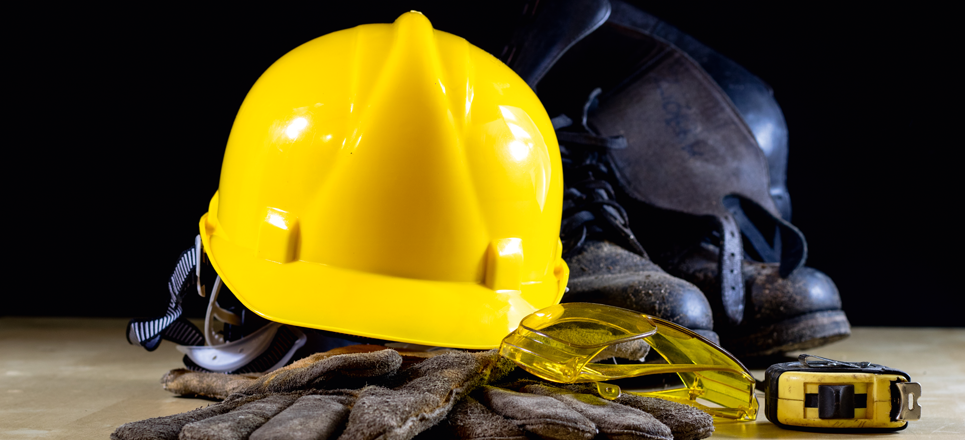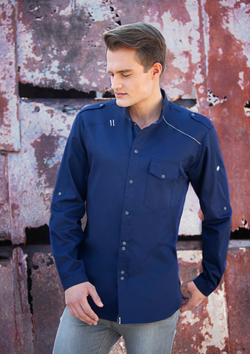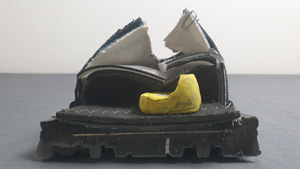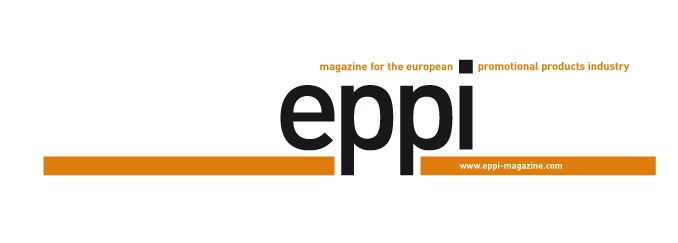The demands that work clothes have to satisfy are as diversified as the garments themselves. However, high-visibility warning clothing, chef coats and safety shoes do all have one thing in common: Great value is placed on product safety.

Postmen wear work clothes, so do nurses, together with builders or technicians. Doctors have their white coats, steel workers their heat protection coats. From safety helms to sunglasses, from gardening gloves through to the lab coat: all of these items are work clothes. Workwear is an advertising medium with special demands. The items are geared up for functionality, but also to protect. And as varied as the tasks of their wearers may be, the demands that work clothes are faced with are as equally diversified.
About boxes and metres
Daniel Best has extremely high demands in workwear, particularly regarding shoes, but then that is actually his job. He namely works for TÜV Rheinland in Leipzig, where he is the expert for the certification of safety, work and occupational footwear. For example, safety shoes protect the toes against burdens of up to 200 joules thanks to a protective toecap. They also have to display a certain residual height. The demands for this residual height are laid down in the ISO Norm 20345. Best transforms abstract figures into a tangible scenario: “Imagine someone is carrying a box weighing 20 kg at a height of around 1 m. Using our test assembly we test whether the toecap will withstand the shock if the box falls onto the shoes.“ Because when 20 kg fall onto a point from a 1 m height that corresponds to precisely the required 200 joules, at least in the vacuum. Best and his colleagues obviously don’t throw boxes at the shoes, they work with a special testing machine that simulates the described scenario. The testing machine cannot recreate the vacuum, but using a wedge that simulates a box it can calculate from which height the 20 kg in weight has to fall from onto the toecap to be tested even without a vacuum. The toecap doesn’t have to be completely intact after undergoing this ordeal, explained the tester, but it has to display a certain residual height. For the shoe size 42 this is 14 mm, for shoe size 39 it is 13.5 mm. “Equipped with a correctly certified safety shoe such accidents shouldn’t cause more than a bruised toe or perhaps broken bones,” said Best. The expert explains immediately however that there is no 100 percent protection: “If 100 kg fall onto the shoes from a height of 1 m, the toecap certified according to ISO 20345 won’t help you either.”
The be all and end all: Hygiene
The fact that safety shoes primarily fulfil the function of protecting and thus underlie strict testing criteria is common knowledge, however not everyone realises that waiters’ aprons are not purely worn for promotion purposes or to facilitate the clearly identification of the service staff. They actually serve to protect clothes from getting dirty or the waiter from burning himself. The characteristic outfits of chefs not only serve identity purposes, but are also a means of protection for both the chef and the people he is serving food to. The material should be hardly flammable, but light to wear and should be designed so that the skin can breathe under it; long sleeves protect the forearms against heat and burns. But the chef’s clothing also protects the guests, namely against bacteria, which could lead to infections. Especially in the catering trade, hygiene is the be all and end all, since the work clothes of the kitchen crew have to withstand being washed regularly at 95 °C, without shrinking, which would render them useless. Sometimes the workwear protects the people with whom the wearer come into contact even if the contact occurs indirectly via a dish of goulash.
The catering clothes specialists Karlowsky are of course aware of this, so they place great value on the hygienic cleaning of their own products, said Michaela Benner, Product Manager at Karlowsky. So samples are tested not only for visual quality defects prior to and after each production batch. Karlowsky also explicitly places the focus on the resistance of the material when washed and machine dried many times from the very beginning of the product development phase onwards as well as at the end in the scope of the quality control of the finished garment. “Among other things we look at the shrinkage behaviour of the items. Our products have to be washable at high temperatures so that dirt and bacteria don’t have a chance,” explained Benner. But not only that: The outfits for kitchen professionals also have to withstand being cleaned industrially with all of the related washing, drying and customising processes.
Tested for harmful substances

Not always white: Chef shirts like these should always withstand being washed at 95°.
In addition to their washability, as with other items of clothing, workwear should also be tested to make sure it doesn’t contain any healthendangering harmful substances. At Karlowsky the products are tested accordingly and their harmlessness is confirmed: “Since our products are certified according to the Standard 100 by Oeko-Tex® our products display a high degree of product safety,” explained Benner. In this way the company aims to guarantee that the products satisfy all human/ecological demands. To obtain a Standard 100 by Oeko-Tex® certification, the products and all of their components are tested in independent laboratories for forbidden and health-endangering substances using scientifically determined standards. The testers particularly focus on the extraction of the harmful substances. After all the most important aspect here is the contamination with health-endangering substances. Substances that can be extracted and come into contact with the skin or get into the lungs have to be put to the acid test and the risk potential determined. Because fabrics and yarns can contain dyes that cause cancer and allergies, pesticides in the case of textiles made of natural fibres, polycyclic aromatic hydrocarbons, organostannic compounds, chlorinated phenols, plasticisers and much more – a list of the substances and the applicable thresholds can be viewed online at Oeko-Tex®. In addition to testing in the laboratory, a company audit as well as a so-called conformity declaration are necessary to receive the test seal. In the scope of the conformity declaration, the manufacturer of the item tested confirms that the products manufactured and sold will correspond precisely with the tested samples in their type and composition during the twelve months term of the certification.
Visibility as protection
Work clothes not only have to be practical, functional, durable and as free from harmful substances as possible, they are frequently also designed to save lives. Safety vests for instance are much more than a brightly colour garment of functional clothing with reflectors attached to it. The official description is “high-visibility warning clothes” or “high-visibility protective clothing” and this term also applies to the corresponding trousers or jackets. These clothes are particularly important when the wearers work close to moving traffic or for instance on building sites or at airports; simply anywhere where visibility protects against injuries – including also fatal accidents – indeed in all weather conditions, at night and in all lighting conditions. Because high-visibility warning clothes can have such a significance for saving the life of the wearer, it is referred to as being so-called “personal protective equipment” (PPE). Such special pieces of work clothes are expressly designed to protect the wearer against injuries or risk to life. There are regulations for these PPEs, which are among others laid down in the PPE Directive (EU) 2016/425, which have to be observed – after all it concerns physical integrity, even and especially when it comes down to something that may seem mundane like a safety vest.
Since the year 2013 high-visibility warning clothes have to be certified according to EN ISO 20471. In this way, the PPE safety vests have to be made out of material in fluorescent colours, because these colours are well-visible during the day. At night reflective material is to reflect the light of headlights and ensure good visibility. Manufacturers of high visibility clothing, such as the British company Result, already pay attention to the legal requirements during development and production: “All styles are tested by our own technicians and staff so any design or fabric questions are ironed out before full production. On arrival at our warehouse, garments in each container are checked for conformity,” Sara Sanders-Smith, the Director of Result, reported. Because what is the use of fluorescent colours if they fade more and more each time they are washed? And what good do reflectors do, if they stop working when subject to temperature deviations and no longer reflect enough light?
Extensive tests
It is the job of Cornelia Pitschel, the colleague of the TÜV shoe expert Best, who has been with TÜV Rheinland for 12 years and who is in the meantime Laboratory Manager at the Leipzig location, to determine whether high-visibility protective clothing actually fulfils the requirements of the standard. Since the norm, to put it briefly, specifies that high-visibility warning clothes are visible in all possibly imaginable situations, the tests are oriented on two factors, namely on their everyday implementation and on the reproducibility of possible situations,” explained Pitschel: “For us it is important to carry out the tests in line with the standard and thus prove the observance of the demands.” This is why the tests endeavour to simulate the influencing factors the clothes are exposed to as accurately as possible. And since there are manifold influencing factors, the tests are as equally manifold. When the safety vests reach Pitschel and her colleagues, they have plenty of tests ahead of them: being kept in a climatic chamber for example for 20 hours at -30 °C and for twelve hours at +50 °C. They will be maltreated with chafing fabric, folded endlessly – namely 7,500 times – washed repeatedly, exposed to simulated rain and irradiated with xenon light that serves to achieve an artificial ageing process. Again and again the testers measure the colorimetrical values and the light density of the fluorescent material as well as the reflective values of the reflective material to answer the key question: Is the garment still visible enough even after the simulated everyday influences?

Broken toecap: This shoe doesn’t satisfy the norm.
But everything begins with a measuring tape: “First of all we measure the surface distribution,” explained Pitschel. Because this is important: The relevant ISO norm for protective clothing also contains regulations regarding the design and above all the surface sizes. There are minimum surfaces for the fluorescent and reflective material, the smallest deliverable size is taken as the basis for the measurements. A large piece of well-visible fabric is quite simply more easily visible than a small piece. It is indeed possible to have protective clothing embellished with a corporate logo. The advertising message is however not allowed to reduce the minimum surfaces of fluorescent background material and the reflectors laid down in the ISO norm. Once the protective garment has successfully passed all tests, incidentally also those regarding the ergonomics and general demands for work clothes according to EN ISO 13688, the inspectors finally take a look at the manufacturer’s specifications. The provision of specific information is also laid down here. If this is not stated, the item of high-visibility warning clothing doesn’t receive the so-called EC type examination certificate 2016/425.
The responsibility is also down to the buyer
Hence, it is a pretty complicated matter to safely produce and sell work clothes and PPE. In order to be totally on the safe side and not to fail any of the complex legal and technical requirements, industry associations provide their support. For example Result is a member of the Retroreflective Manufacturers Association (REMA) that is based in Winchester, Great Britain: “The association keeps us up to date with any changes in certificate requirements,” Sanders-Smith said. She considers the quality level of the work clothes that are used for promotion and advertising purposes to be high overall, but does make one decisive statement: “Customers must understand that it is their responsibility to ensure the garment they choose is correctly certified and fit for its intended purpose.”
// Klara Walk
Photos: Karlowsky Fashion; TÜV Rheinland LGA Products, Leipzig; shutterstock.com/Piotr Wytrazek
Anti-slip is not always anti-slip
There are different standards for all possible shoes that are worn for work purposes. The relevant industry standard for safety shoes is EN ISO 20345 this norm is divided up into different classes depending on the features of the safety shoe. The abbreviation SB stands for a type of basic version of a safety shoe: All of these shoes are equipped with a toecap. The classes S1 to S5 denote different aspects alongside the obligatory toecap, which are important for work carried out in different environments. In the case of occupational footwear certified according EN ISO 20347 on the other hand different abbreviations describe special protective effects. For example the abbreviations SRA and SRB refer to anti-slip attributes. SRA shoes are tested for their anti-slip function on ceramic tiled floor, their behaviour on standard tiles treated with sodium lauryl sulphate and water – which effects the floor as if it has just been cleaned – is tested. SRB shoes are anti-slip on steel floors that have been wet with glycerine. The abbreviation SRC on the other hand indicates that the respective shoes have been tested for their anti-slip function on both tiles and steel floors.



